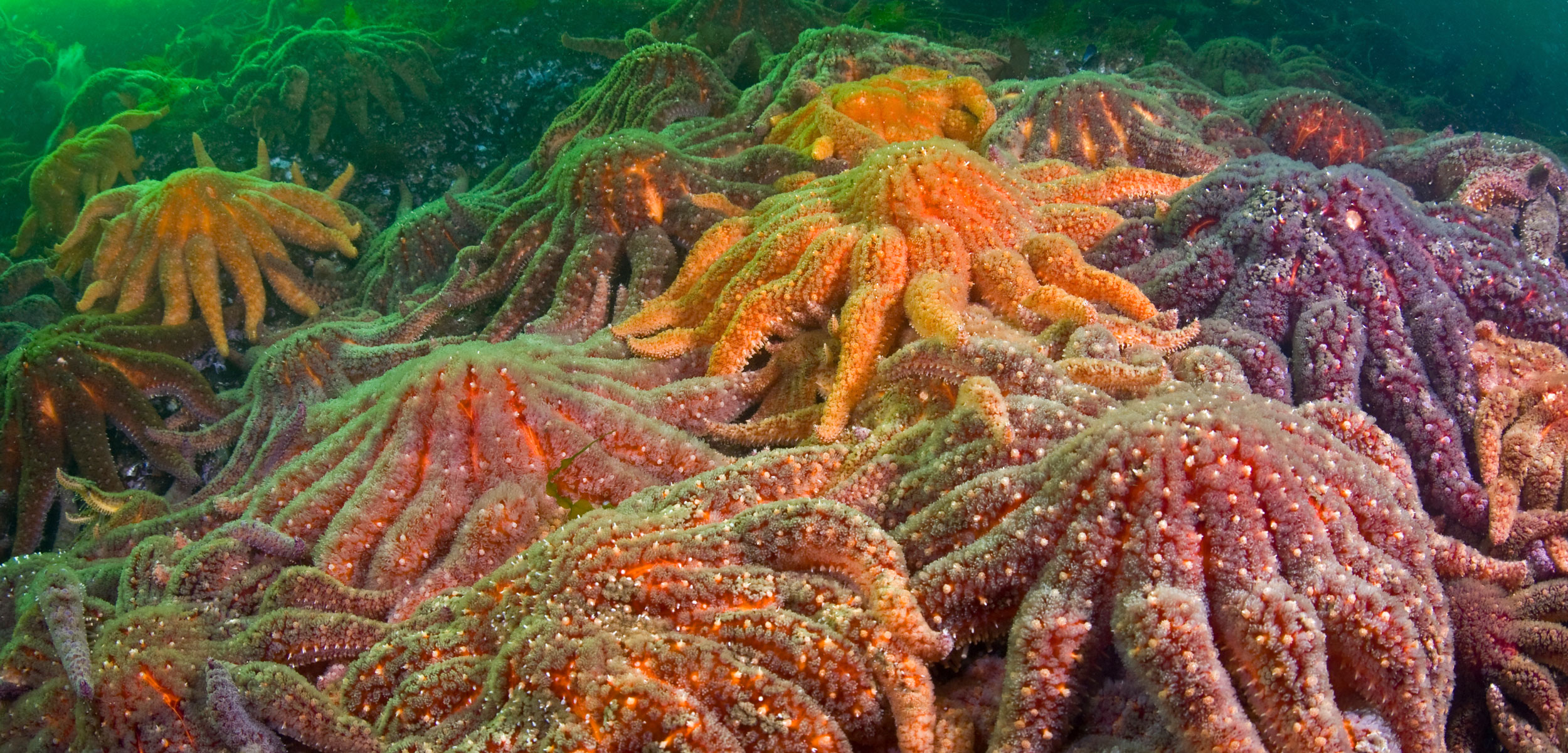Sea Star Wasting Disease, Revisited
A new survey of deepwater sea stars adds to observations of their coastal counterparts to unveil the full scale of the destruction caused by the epidemic.
Article body copy
Before 2013, the Pacific coast of North America was rich with sea stars—some 30 different species ranging from deepwater dwellers to the purple or ocher sea stars of the intertidal zone. Then, in the summer of that year, scientists and others watched with horror as one of the largest marine die-offs in modern history played out before them. From Mexico to Alaska, sea stars withered and died, their bodies dissolving into mush, leaving nothing but goo and spines behind.
Over the next two years, as geographically diverse populations continued to crash, scientists coined the term sea star wasting disease (SSWD) to refer to the unexplained forces that were causing the devastation. SSWD has now laid waste to untold millions of sea stars along the coast, although some areas and species have been harder hit than others. The sunflower star, once an abundant species, is now locally extinct across much of its natural range, from British Columbia to California.
Now, a new study* led by Drew Harvell, an ecologist and evolutionary biologist at Cornell University in Ithaca, New York, examines the complex confluence of factors that seem to have powered the epidemic. To preexisting observations for coastal specimens, the team added data on sea star biomass collected by deepwater trawls done between 2004 and 2016—information that covers the population pre- and post-outbreak. For both the deepwater and coastal environment, they link a marine heatwave and a virus, called the sea star-associated densovirus, to the sudden decimation of sunflower stars.
“Temperature is a big deal for the disease; infectious microbes do better in warmer temperatures,” says Harvell. “The sea stars don’t have a chance when it’s warm.”
Although warming ocean temperatures appear to play a role in exacerbating the disease, as more research and data continues to come in, any tidy, unified answer as to what single factor or combination of factors caused SSWD has proved elusive.
“When you look across some of these big outbreaks we’ve had in the past it takes a very long time to get to the end answer,” says Harvell. “I think there are a lot of different opinions right now. Unfortunately, there hasn’t been a lot of funding to investigate the causative agent.”
For different sea star species, varying elements seem to have led to the same disastrous results. Although the virus appears to have spelled doom for sunflower stars, other sea star species are not affected by it. For them, environmental factors such as drought, pollution, and bacteria are suspected to have played a role.
But the mass die-off plainly reveals the vital role sea stars play in maintaining balance in their ecosystems. In the past few years, Northern California, for example, has lost 90 percent of its once-vast kelp forests. As the sea star populations collapsed, the number of kelp-munching purple urchins—a favorite prey of sunflower stars—increased 60-fold. As a result, biologically diverse, kelp-reliant ecosystems have now been replaced with urchin barrens, underwater expanses carpeted with the spiky purple creatures.
As the ultimate cause of SSWD is unknown, scientists are unsure whether the sea star populations will eventually make a comeback. But given the epidemic’s large geographic range and the variable death rates, it’s probable that some populations could recover. Already there are a few hopeful glimmers. The survival rate of baby sea stars of a number of species has dramatically increased along parts of the Oregon coast, for instance, although it remains to be seen how many of these juveniles will survive to maturity.
However, Harvell and her colleagues note that the densovirus is still lurking in some resilient populations, ready to leap from asymptomatic carriers to susceptible juveniles. A general return to the pre-2013 sea star abundance seems unlikely, Harvell says.
Despite the massive die-offs and the continued, though significantly reduced, presence of SSWD, some scientists such as Cornell University marine microbiologist Ian Hewson remain hopeful that sea stars may eventually recover by adapting to the new environmental conditions.
Hewson, who was not affiliated with Harvell’s team, says that animals such as sea stars that reproduce quickly and in large numbers tend to adapt pretty rapidly to environmental change.
“It’s like that quote from Jurassic Park, ‘Life finds a way,’” he says. “That might be the case with the sea stars.”
*The study’s authors include researchers with the Hakai Institute. Data from Hakai Institute monitoring projects was also used in the study. The Hakai Institute and Hakai Magazine are both part of the Tula Foundation. The magazine is editorially independent of the institute and foundation.

